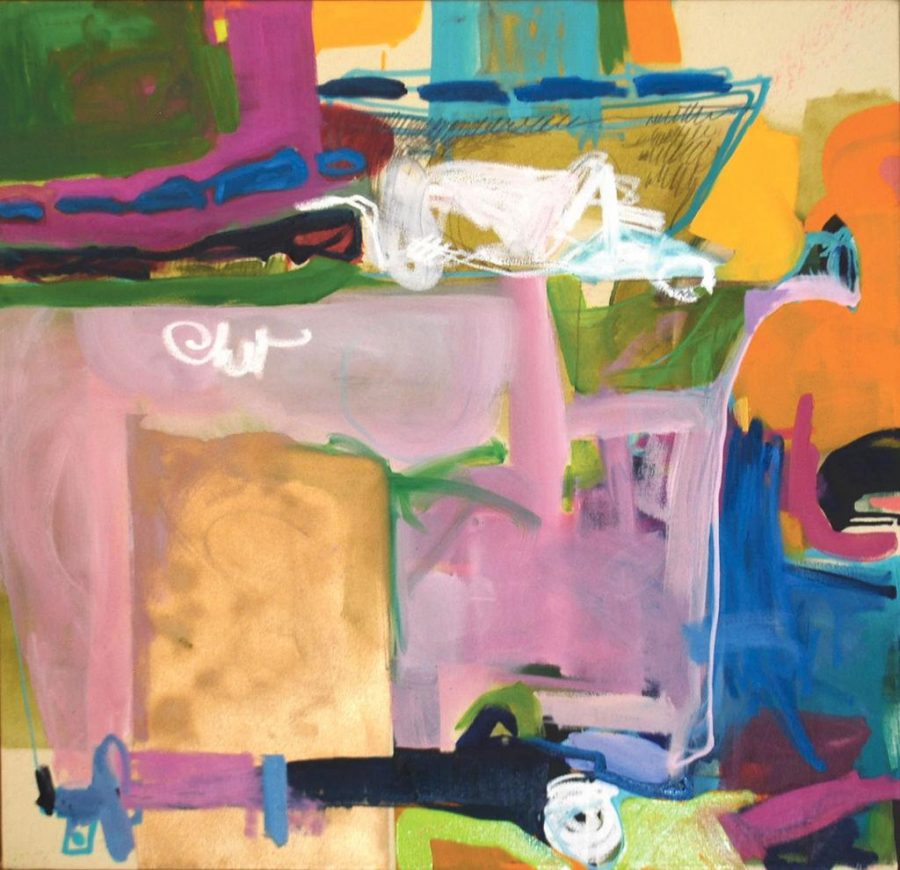One’s trash is another’s treasure: Exhibit litters The Warhol with abstract, neon dumpsters
July 7, 2015
Not all artists start off with a brush and canvas — for Pittsburgh artist Elizabeth Rudnick, the 1990s version of Microsoft Paint was enough to get started.
“At six, I was tying up my parents’ computer for hours at a time, completely blissed out on MS Paint,” she said. “By nine it was either become an artist or the fifth member of AQUA, and by the time I got to college, art had won out.”
While the “Barbie Girl” singers fizzled out with the ‘90s, Rudnick is now featuring her work at The Andy Warhol Museum’s latest summer installation, “TREASURE/TRASH.” The exhibition is the third edition of The Warhol’s “Exposures” series, which puts contemporary artists’ work in dialogue with objects in the museum’s permanent collection. The museum showcases ”Exposures” in its three street-facing windows — a homage to Warhol’s early career, when he dressed windows to get attention from buyers and curators.
For “TREASURE/TRASH,” Rudnick created three large abstract compositions that will be featured in the windows, surrounded by items she picked from the gift shop, starting on July 8. On Saturday, July 11, The Warhol will hold a “Meet the Artist” event, where visitors will have the opportunity to speak with Rudnick.
Originally from Denmark, Rudnick earned her Bachelor of Fine Arts from Carnegie Mellon University in 2012. She has shown her work at places including the Pittsburgh Glass Center, Three Rivers Arts Festival and The Miller Gallery. Her work on “TREASURE/TRASH” began when the museum’s assistant curator, Jessica Beck, saw Rudnick’s exhibitions at The Mine Factory and The Lawrence Hall Gallery over the past two years.
Rudnick often experiments with mediums, materials and messages between projects. For 2013 and 2014’s “Family History” series, she painted over photographs to represent changes in memory over time. She’s also made digital prints, and often uses graphite, acrylic and oil in her art.
Impressed by her works, Beck invited Rudnick to visit The Warhol and brainstorm ideas for a potential exhibition with the institution. Beck asked Rudnick to create new paintings for the next “Exposures” display, which previously featured local artist Cecilia Ebitz’s “Good Intentions,” a collection of colorful canvases inspired by late pop artist Corita Kent.
According to Beck, “Exposures” provides the opportunity to both showcase up-and-coming talent and reinterpret Warhol’s work with a modern perspective.
“It brings contemporary emerging artists in the city in dialogue with our work in the museum. So it’s new each time,” Beck said. “A lot of his work with societal issues and culture is still very contemporary today, which is amazing that’s kind of what speaks to artists today.”
After Rudnick agreed to the “Exposures” project, she looked through The Warhol’s permanent collection to find something to inspire her paintings. Rudnick eventually came across Warhol’s “Truck,” 1985, a little-known series of four prints he made for the 20th World Congress of the International Road Transport Union.
When Rudnick looked at “Truck,” which depicts a tractor-trailer in various neon hues, she noticed similarities to her 2014 “Dumpster” works. Similar to “Truck,” her collection frames dumpsters — a frequently overlooked everyday object — within unusual colors, angles and locations.
“Dumpsters populate every street, from [a] broken-down alley to mansion-side driveway, yet we’re not really supposed to pay attention to them. When you do start paying attention, you realize that they’re really interesting,” Rudnick said. “’Truck’ also has geometry that very much relates to the type of structure that I try to build in my paintings, especially the ‘Dumpster’ series.”
After she compared her art with Warhol’s, Rudnick made window displays that highlighted her dialogue with the famous pop artist, yet advanced the commentary of her “Dumpster” works. “Lawrenceville” is one of the 2014 works Rudnick is referencing, which shows a salmon-colored dumpster surrounded by smudged, vibrant geometric patterns. Instead of using canvas on the new paintings, she’s experimenting with translucent fabric as a nod to Warhol’s screen printing process that initially earned him popularity.
Rudnick also chose several items from The Warhol’s gift shop to go alongside her art, including penny bank Coca-Cola bottles, banana-inspired objects and bookends resembling balloon dogs.
For Rudnick, the quirky products she chose go along with the “TREASURE/TRASH” concept, and they continue the tradition of Warhol’s famed treatment of everyday items.
“His ‘Brillo Boxes,’ his ‘Campbell’s Soup Cans’ — for me, they’re wonderful because they successfully elevated the cheap and ubiquitous to the nearly priceless. A ton of contemporary art owes its legitimacy to that success,” Rudnick said.
While Rudnick recognizes Warhol’s influence on contemporary art, “TREASURE/TRASH” ultimately aims to react to — and even challenge — the tradition he established. With the exhibition, Rudick is looking to explore the rising amount of ignored objects on the streets, rather than the household items Warhol worked with during his career.
“This legacy, while extraordinary, has consequences for emerging artists today,” Rudnick said. “The title TREASURE/TRASH is also a reference to that — the ideological pushback against the commodified, fabricated, commercialized art market that Warhol and Koons helped to create. It’s treasure, and it’s trash.”



